Magazine
Design incorporates objects, people,
ideas based on the small pleasures of everyday life.
Meet your Beautiful design world with the DDP Design Fair.
-

FURNITURE
COLLABORATION/PAPER POP+TGC_FGWe believe paper-based furniture is ideal for occupying spaces temporarily. As a result, we designed stools that can be used at pop-up events or outdoor gatherings. The structure is created using a flat-pack design, making it easy to assemble. The stool can be used individually; however, when arranged in a hexagonal pattern, it transforms into a bench, creating a space where multiple people can sit on. Furthermore, it can be expanded at various angles, allowing for different linear or circular setups, making it adaptable to various environments.MAKER PAPER POPMany people tend to focus only on the aesthetics when creating paper furniture, but in this collaboration, we were able to share ideas not only on the visual design but also on pricing and engineering, which made the process much more exciting. From PAPER POP’s perspective, the stool was an exciting product. It was great to collaborate with the designer and combine their expertise in corrugated cardboard with PAPER POP’s experience.DESIGNER TGC_FGWhen I first met with the manufacturing company, it didn’t feel like they were just creating a simple upcycling brand. Instead, I could sense their genuine effort to explore how cardboard could impact the environment and promote human values. It was refreshing to see such sincerity in their approach to designing everyday objects. Understanding the types and characteristics of the corrugated cardboard used at PaperPop was insightful, and the opportunity to study the load-bearing capacity of the materials in practical use was a valuable experience.
2024-12-0345 -
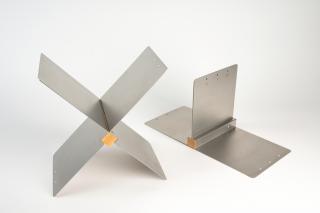
Daily supplies
COLLABORATION/TRIPLE H+iiiinteThe OX Book Stand was designed by exploring the fundamentals of form and material properties to create a versatile and functional product. Crafted from stainless steel and beech wood, a type of hardwood, it offers both durability and elegance. The stand features X-shaped joints that allow the angle to be adjusted, enabling the product to be used in two different configurations. This design also makes it easy to assemble and disassemble. The X-shape is ideal for stacking books diagonally, while the T-shape functions as a bookend for temporarily holding books. The L-shape lets you insert books between the separated pieces, allowing the stand to also function as a standalone bookend.MAKER TRIPLE HThe designer reinterpreted the product’s form and function with a creative approach, proposing a design that goes beyond traditional boundaries. Through this collaboration, a product was created that combines both user convenience and visual beauty. Moving forward, I look forward to continuing collaboration with many designers to create more exceptional products.DESIGNER iiiinteI typically design and create products using wood alone, but in an effort to create new synergies, I sought to collaborate with a manufacturer that specializes in other materials. With a particular interest in modular design, I set out to pursue a modular approach for this project. I proposed the collaboration with TRIPLE H, confident that we could achieve exceptional results together. After exploring furniture made from a combination of simple wood and stainless steel, we decided to shift from an all-metal design to one that integrates both wood and metal, leading to the creation of the current product.
2024-12-0351 -
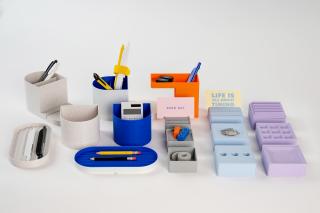
Daily supplies
COLLABORATION/CREAFT+EUNJI KANG, JIYAE PARKDosirak Stationery brings the spirit of a picnic to your desk, offering small moments of joy throughout your day. By swapping chopsticks for pens and side dishes for everyday items, you can craft a personalized space wherever you are. This design aims to make your daily routine more enjoyable, transforming your desk into a space you look forward to.The modular design allows for easy stacking and transportation, so you can organize and move your workspace with ease. The Velcro ties are reusable for organizing items such as cables and pens, keeping your workspace tidy.Designed for versatility, this modular stationery is crafted using 3D printing, offering custom color variations and engravings on each component, making it an excellent choice for B2B corporate applications.MAKER CREAFTThe process of turning the product into a reality through 3D printing was fascinating. Together with the designer team, we exchanged ideas on design and engineering methods for 3D printing production, working towards making the product ready for mass production. Through various trials and research,we successfully created a marketable stationery product, making it a unique and valuable experience. Through this collaboration, our goal was to ensure that 3D printing technology went beyond simple prototype creation, enabling us to bring the product to mass production.DESIGNER EUNJI KANG, JIYAE PARKIt was a rewarding experience to collaborate with CREAFT, a company that uses biodegradable filaments derived from plants for all of its materials. Rather than relying on traditional injection molding for mass production, we utilized 3D printing technology to create customized product series. Seeing the high quality of the finished products, which were not just samples but ready for sale, made me realize the true potential of 3D printing. Going through the various sampling processes and experiencing the actual product production was a valuable experience.
2024-12-03122 -
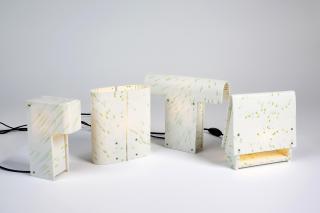
LAMP
COLLABORATION/The 4th Space+Youngjin Shin, Changwoo JeongThe Kerf Series Lighting, utilizing the Kerf Bending technique commonly used in woodworking, reflects the design philosophy of "The 4th Space" through its focus on recycled plastic sheet processing.This lighting series introduces innovative ways to create light patterns using consistent groove widths for bending. The grooves not only enable structural flexibility but also shape the way light diffuses, showcasing fresh ideas with diverse forms and structures.To stay true to sustainable design principles, we minimized the use of other materials, creating an entirely eco-friendly lighting solution from sheet-processed recycled plastic. The Kerf Bending technique, with its CNC-machined grooves, allows light to pass through the bends, creating a unique design where the light naturally diffuses as it forms curved surfaces.MAKER The 4th SpaceThis product leverages the Kerf Bending technique to create curved forms while allowing light to pass through the kerfs, producing distinctive light patterns. Unlike typical designs where sheet materials are used as static shades that block light, this project sought to go beyond such limitations by utilizing the material's properties, thickness, and processing techniques to create a design where the light naturally integrates with the sheet material.DESIGNER Youngjin Shin, Changwoo JeongDuring the initial meeting with *The 4th Space*, a company specializing in the processing of recycled plastic sheets, we exchanged ideas on various fabrication methods and CMF (Color, Material, Finish) techniques achievable through sheet processing. While brainstorming ideas for lighting, we incorporated the Kerf Bending technique, commonly used in woodworking, and focused on the unique characteristics that emerge during the bending process. This led to the development of a lighting concept utilizing kerf bending patterns.As it was our first time working with this technique, we explored a variety of creative and enjoyable approaches. Combined with *The 4th Space*’s expertise in production, this collaboration was both engaging and highly educational. The project successfully demonstrated the diverse potential of lighting fixtures made with recycled plastic, marking it as a meaningful and impactful experience.
2024-12-0353 -
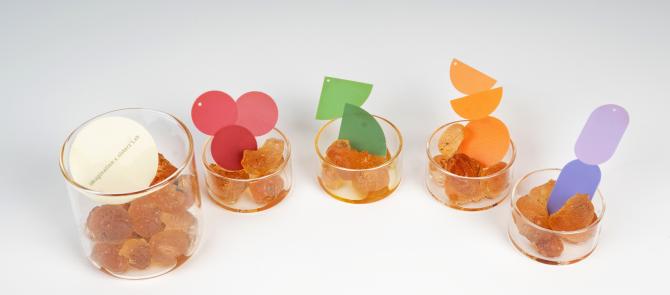
Daily supplies
COLLABORATION/Imagination+sisterz’ LabThis kit combines a fragranced object infused with natural scents with a wind chime that produces sound when touched by the wind. The mobile-like design adds visual interest, while the DIY element enhances the sensory experience in multiple ways.Crafted from eco-friendly materials, the product features a paper fragrance tag infused with fragrance oils, providing a lightweight and versatile expression. With a fresh, invigorating base scent, users can customize the mobile by layering additional single scents, such as mandarin, lavender, patchouli, and geranium, on the fragrance tags.The packaging is minimal and simple, using FSC-certified paper and eco-friendly bags instead of plastic. It also includes recyclable elements, giving the overall design an environmentally conscious touch.MAKER ImaginationThrough our collaborating designer’s innovative ideas, we were able to create an exciting product. Working together from the product planning stage provided valuable learning opportunities in the field of design. I believe this collaboration has been a great starting point for creating more unique fragrance objects with great ideas for the future.DESIGNER sisterz’ LabThe collaboration of scent and design was a great opportunity to explore new ideas and expand our understanding of each other’s fields. With valuable input from our mentors, we were able to create an exciting product. This fair provided a valuable opportunity to promote our perspective brands and take a step forward.Initially, I wasn’t deeply familiar with the intricate aspects of scent, but thorough discussion and exchange of ideas helped me gain valuable insights. The concept of natural scent was particularly inspired by the element of wind, and together, we focused on designing an object that captures the essence of a landscape carried by the wind.
2024-12-0350 -
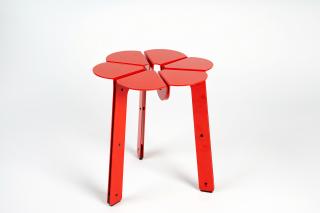
Daily supplies
COLLABORATION/TaeKwang Precision+Like A"The Flower" is a metal stool inspired by the beauty of flowers, one of nature's most precious gifts. Just as several simple, familiar petals come together to form a beautiful flower, the stool is assembled by repeatedly arranging two identical pieces, creating a shape that resembles a flower. As a stool, the product provides stability and convenience for the user, while also creating an interior effect that evokes the feeling of a flower blooming in the home.MAKER TaeKwang PrecisionThe final design and product development took a significant amount of time. Nevertheless, the CEO of the manufacturing company played a key role in the process, offering valuable advice. With their expertise in metal processing, material knowledge, and advanced technical skills, we received tremendous support throughout the production of The Flower. Particularly, the collaboration allowed us to experience the detailed production process and discuss how the product could transition into mass production.DESIGNER Like ACollaborating with small businesses and exchanging specialized knowledge has been an invaluable learning experience. We gained insight into how to use eco-friendly materials and enhance marketability. Initially, we were focused only on the artistic aspects of our work, but thanks to MUDA's guidance on market potential, we now understand how to improve the product’s commercial appeal.
2024-12-0347 -
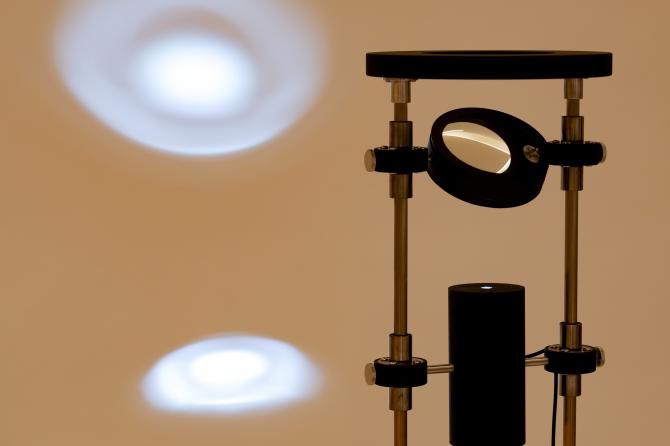
LAMP
COLLABORATION/TaeKwang Precision+stoxlThe "ro-x / m-z light" is a kinetic floor lamp that applies the principles of light reflection and refraction. Users can gradually adjust the diffusion range by altering the distance between the central light source and the mirror disc, as well as by changing the type of mirrors placed on both sides of the disc. The 360-degree rotating mirror disc allows users to reflect light in their desired direction. These kinetic elements not only provide an interactive experience but also enable a single lamp to serve multiple functional purposes.The ro-x / m-z light integrates both rotational and vertical movements into its design, using circular-cut rods, pipes, and mechanical components. This approach emphasizes geometric modernity and the rhythmic aesthetic of machinery. To maximize the lighting effects, the parts exposed to light are finished with a matte black anodized coating, while the moving components highlight the texture of the metal, further intensifying the interplay of light, movement, and form.MAKER TaeKwang PrecisionPrecision processing is at the heart of this product, making it a personal achievement for me. The lighting fixture incorporates scientific principles and was designed with an assembly-based approach to achieve a clean finish, without the need for welding. It also features precision technology for both vertical and rotational movements. Having gained knowledge and expertise in precision machining since 1985 by working on projects at Cheonggyecheon, it was a great opportunity to share that experience with younger generations. I look forward to continuing collaborations with designers to create great products.DESIGNER stoxlTaeKwang Precision workshop was just a short walk away from my place, so during the prototype processing, we worked closely every day until the factory’s CEO left for the day. As a designer, observing and learning from the precision machining process was incredibly valuable. We look forward to continuing our collaboration on various projects in the future.
2024-12-0356 -
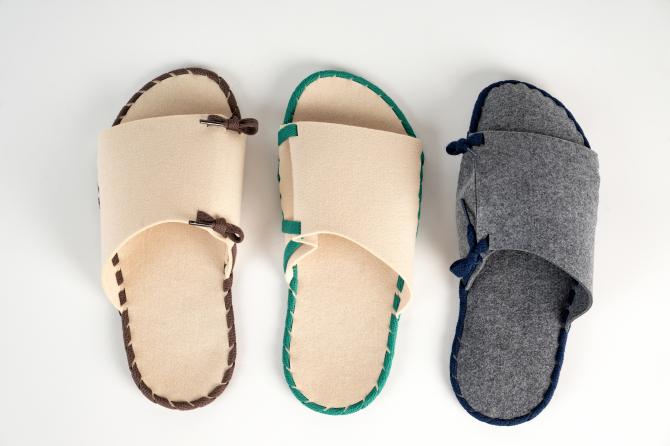
Daily supplies
COLLABORATION/A Meaningful Life Inc.+0TOX StudioThe Ribbon Project, organized by A Meaningful Life (Uisikjuwi), was created to promote a circular economy and a sustainable environment by recycling clean, discarded five-star hotel beddings instead of incinerating them. The growing amount of textile waste is significantly contributing to the global warming crisis.In response, A Meaningful Life developed recycled felt from clean, discarded hotel bedding. This recycled felt helps reduce textile waste and transforms single-use products to be repurposed for multiple uses. The project collaborated with Zero to X (0TOX), a brand dedicated to creating meaningful, high-quality products, to design reusable slippers that can replace the single-use slippers commonly discarded in hotels.MAKER A Meaningful Life Inc.A Meaningful Life Inc. focuses on developing sustainable fabric materials and using these materials to create everyday items such as pajamas, underwear, and bedding—products that come into direct contact with the skin. We have previously collaborated with five-star hotels to develop upcycled materials from discarded bedding. Our goal is to make this material more practical and beneficial for consumers, while also giving it a unique designer’s perspective that moves beyond traditional ideas. Our collaborating designer proposed innovative solutions that addressed the limitations of conventional slippers, resulting in a final product that exceeded our expectations.DESIGNER 0TOX StudioWhen collaborating, I believe it’s essential to communicate actively, allowing ideas and concepts to develop naturally through a smooth exchange. In this project, we had great synergy in that regard, and I felt very comfortable working as a designer, thanks to the trust placed in me. Ultimately, the collaboration helped the project evolve in a much better direction.
2024-12-0348







